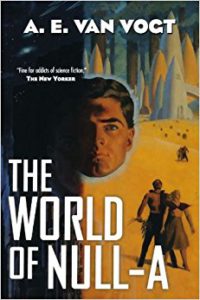 This novel was one of the first-ever written and published as a sci-fi book, not collection of stories from a magazine like “Astounding Science Fiction.” It’s hard to imagine, but there was no “science fiction” category for books yet. The World of Null-A helped define the genre at the end of World War II.
This novel was one of the first-ever written and published as a sci-fi book, not collection of stories from a magazine like “Astounding Science Fiction.” It’s hard to imagine, but there was no “science fiction” category for books yet. The World of Null-A helped define the genre at the end of World War II.
The setup is that there is a sentient machine that somehow controls the new human zeitgeist of non-Aristotelian thought, which is defined here as rejection of the rule of the excluded middle. In classical logic a thing cannot both be, and not be, at the same time. It is either A, or not-A (aka null-A), with nothing in the middle.
In today’s world of “fuzzy” or probabilistic logic, that premise can be doubted, but in this book, the innovation is that Null-A thinkers are non-Aristotelians. For them, a thing CAN be A and not-A at the same time. Nevertheless, the hero, Gilbert, seems perplexed by it. Being a Null-A person is portrayed as a good thing, though the reasons why that’s so are not clear.
Naturally, there are those who are “against” non-Aristotelian thinking and would like to destroy it, and the Machine. Gilbert discovers a vast, quasi-governmental conspiracy stretching across the whole galaxy which plans to invade Earth and take down the system. They are “bad.” Gilbert is “good.” That’s all you need to know about that.
In the early pages, shockingly, Gilbert is killed! You don’t expect that in any story. But no worries, he can both be and not be. So he re-appears as Gilbert II and continues his quest to save the world. It wasn’t a resurrection or a reincarnation, just an act of non-Aristotelian logic. If you have to ask about the details, you are clearly not Null-A material.
As the story goes on, it becomes a series of episodic adventures, chases, narrow escapes, double-crosses, and mixups; one damn thing after another. One enduring image is a mansion cut from the inside of a tree trunk, with polished wooden walls (of course!) and tunnels going down into the roots. Loved that.
People smoke incessantly in this world, as they did after the war (we old people still call it “the war”). I wonder how long it will be before smoking tobacco is seen as such a bizarre cultural practice that it won’t be understood anymore. It’s hard to think of a comparable historical habit that seemed natural at the time but bizarre now – maybe covering your body in leeches to “let” blood for medical reasons?
I think the book counts as psi-fi because the driving concern of the hero is his self-identity. He knows he was killed and he is now Gilbert II, allegedly even with “a new brain,” yet his personal memories, while spotty, seem like his own, as does his personality and his “self,” so his situation raises the worthy question of what constitutes a “self.” Why do we believe, for example that we are the same person today that we were yesterday, especially considering that overnight we went unconscious and were nothing, existing nowhere. How does that work? What if today’s memories were artificially implanted while you slept and aren’t really yours?
Van Vogt’s writing is at best workmanlike and the story line is all over the place, and the character development is nugatory. But the book is fun to read for its historical value and to marvel at things like people in the distant future having trouble “getting an outside line” to make a phone call.
Van Vogt, A.E. (1945/2002). The World of Null-A. New York: Tom Doherty Associates (272 pp).